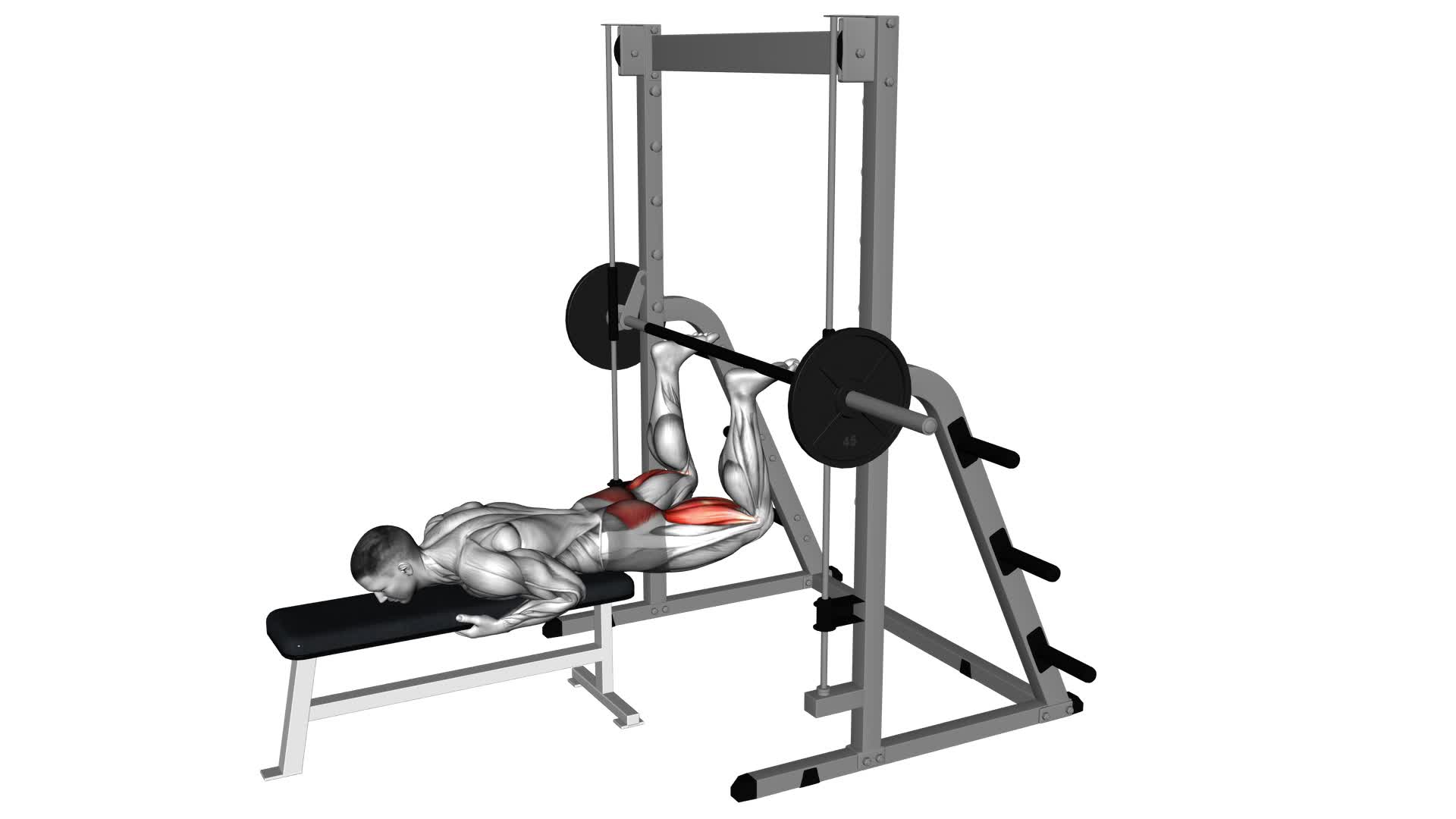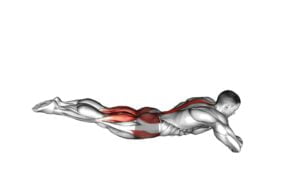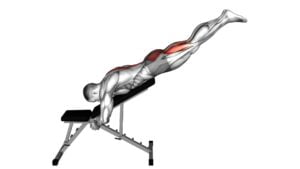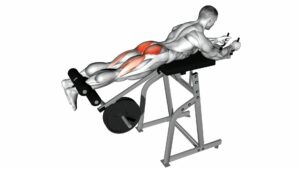Smith Reverse Hyperextension (male) – Video Exercise Guide & Tips

Are you looking for a new exercise to target your lower back and glutes? Look no further than the Smith Reverse Hyperextension.
Watch This Exercise Video
In this video exercise guide, we'll show you the proper form and technique for this effective exercise. You'll also learn common mistakes to avoid and modifications to make it more challenging.
With these tips, you'll be able to incorporate the Smith Reverse Hyperextension into your workout routine and achieve the results you desire.
Let's get started!
Key Takeaways
- Smith Reverse Hyperextension is beneficial for strengthening the lower back and glutes.
- Proper form and technique involve engaging core muscles and squeezing glutes for stability.
- Common mistakes to avoid include arching the back too much and relying on momentum.
- Modifications and variations can be made by using alternative equipment or incorporating resistance bands for increased intensity.
Benefits of Smith Reverse Hyperextension
Experience the numerous benefits of the Smith Reverse Hyperextension, a highly effective exercise for strengthening your lower back and improving overall core stability. The Smith Reverse Hyperextension primarily targets the muscles of the lower back, including the erector spinae, gluteus maximus, and hamstrings. These muscles play a crucial role in maintaining proper posture, supporting the spine, and facilitating movements such as bending, twisting, and lifting. By strengthening these muscles, you can reduce the risk of lower back pain and injury.
To progress and increase the intensity of the Smith Reverse Hyperextension, there are several options. One way is to add weight by holding a dumbbell or a weighted plate against your chest while performing the exercise. This added resistance challenges your muscles and promotes further strength gains. Another way to increase intensity is by adjusting the positioning of your body. For example, you can position yourself further away from the pivot point to increase the leverage and difficulty of the exercise. Additionally, you can perform the exercise unilaterally by focusing on one leg at a time, which further engages your stabilizer muscles and increases the challenge.
Incorporating the Smith Reverse Hyperextension into your workout routine can lead to improved lower back strength, enhanced core stability, and reduced risk of injury. Start with proper form and gradually progress by adding resistance and adjusting the positioning to maximize the benefits of this exercise.
Proper Form and Technique for Smith Reverse Hyperextension
To perform the Smith Reverse Hyperextension with proper form and technique:
- Start by positioning yourself on the machine facing downwards. Adjust the height of the machine so that your hips are positioned at the edge of the bench and your feet are secured under the foot pads. Place your hands on the handles or on the sides of the bench for stability. Engage your core muscles by tightening your abdominal muscles and squeezing your glutes.
- Once you're in position, slowly lower your upper body towards the floor while keeping your legs straight. As you lower your body, focus on using your glutes and lower back muscles to lift your legs up towards the ceiling. Pause for a moment at the top of the movement, then slowly lower your legs back down to the starting position. Repeat for the desired number of repetitions.
If you don't have access to a Smith machine, there are alternatives you can try:
- One option is to use a stability ball to perform reverse hyperextensions. Lie face down on the ball with your hips at the edge and your feet secured under a sturdy object.
- Another alternative is the bodyweight reverse hyperextension, where you perform the movement on the floor without any equipment.
Having a strong core is crucial for performing the Smith Reverse Hyperextension effectively. The movement primarily targets the lower back and glutes, but it also engages the core muscles to maintain stability and control throughout the exercise. By strengthening your core, you can improve your overall performance and reduce the risk of injury.
Now that you know the proper form and technique for the Smith Reverse Hyperextension, let's move on to the next section, where we'll discuss common mistakes to avoid during this exercise.
Common Mistakes to Avoid During Smith Reverse Hyperextension
Now let's delve into the common mistakes you should avoid when performing the Smith Reverse Hyperextension. To ensure proper form and maximize the effectiveness of this exercise, be mindful of the following:
- Arching your back too much: Avoid excessive arching of your back during the movement. This can put unnecessary strain on your lower back and increase the risk of injury. Keep your back in a neutral position throughout the exercise.
- Using too much weight: It's important to use an appropriate amount of weight that allows you to maintain control and execute the exercise with proper form. Using excessive weight can compromise your form and lead to muscle imbalances or injuries.
- Relying on momentum: Avoid relying on momentum to swing your body during the exercise. This takes away from the targeted muscles and reduces the effectiveness of the movement. Instead, focus on controlled and deliberate movements.
- Neglecting core engagement: Engaging your core is crucial for stability and maintaining proper form. Make sure to activate your core muscles throughout the exercise to provide support and protect your lower back.
Modifications and Variations for Smith Reverse Hyperextension
To enhance your Smith Reverse Hyperextension workout, there are several modifications and variations you can incorporate.
If you don't have access to a Smith machine, you can still perform reverse hyperextensions using alternative equipment such as a hyperextension bench or a stability ball. These options allow you to target your lower back, glutes, and hamstrings in a similar way.
When it comes to advanced techniques for Smith Reverse Hyperextension, you can try incorporating resistance bands or ankle weights to increase the intensity of the exercise. By attaching resistance bands to the Smith machine or wearing ankle weights, you add extra resistance, challenging your muscles even more.
Another variation to consider is performing single-leg reverse hyperextensions. This variation not only targets your lower back and glutes but also helps improve balance and stability. To do this, simply perform the exercise with one leg at a time while keeping the other leg extended straight in the air.
Remember, it's important to always maintain proper form and listen to your body. If you experience any pain or discomfort, stop the exercise immediately.
Tips for Incorporating Smith Reverse Hyperextension Into Your Workout Routine
Start by incorporating Smith Reverse Hyperextension into your workout routine with at least two sets of 10 reps. This exercise is a great way to strengthen your core muscles and prevent lower back injuries during exercise. Here are some tips to help you incorporate Smith Reverse Hyperextension into your routine effectively:
- Warm up: Before starting this exercise, make sure to warm up your body with some light cardio exercises. This will increase blood flow to your muscles, preparing them for the workout ahead.
- Proper form: Maintain proper form throughout the exercise. Place your hips and lower abdomen on the pad, and keep your legs straight. Engage your core muscles as you lift your legs upward, focusing on using your glutes and hamstrings.
- Gradually increase intensity: Start with a weight that challenges you but allows you to maintain proper form. As you progress, gradually increase the weight to continue challenging your muscles.
- Listen to your body: Pay attention to any discomfort or pain in your lower back. If you experience any, stop the exercise immediately and consult with a fitness professional to ensure you're performing it correctly.
Incorporating Smith Reverse Hyperextension into your workout routine can help you improve your core strength and prevent lower back injuries. Remember to always prioritize proper form and listen to your body to ensure a safe and effective workout.
Frequently Asked Questions
What Is the Recommended Number of Sets and Repetitions for the Smith Reverse Hyperextension Exercise?
The recommended number of sets and repetitions for the Smith reverse hyperextension exercise can vary depending on your fitness goals and current fitness level. It's generally recommended to start with 2-3 sets of 10-12 repetitions.
This exercise can help strengthen your lower back, glutes, and hamstrings while improving your posture. To perform it properly, lie face down on the machine with your hips resting on the pad and your feet secured under the footrest.
Remember to consult with a fitness professional for proper form and to explore variations of this exercise.
Can Smith Reverse Hyperextension Help With Lower Back Pain?
The smith reverse hyperextension can be a valuable addition to your lower back pain relief routine. It helps strengthen the muscles in your lower back, which can provide support and stability, potentially reducing pain.
However, if you have a pre-existing lower back condition, it's important to take precautions and modify the exercise accordingly. Consult with a healthcare professional or a qualified trainer to ensure proper form and avoid exacerbating any existing issues.
Are There Any Alternative Exercises That Target the Same Muscle Groups as the Smith Reverse Hyperextension?
If you're looking for alternative exercises that target the same muscle groups as the Smith Reverse Hyperextension, there are a few options you can try.
One option is the glute bridge, which activates the glutes and hamstrings.
Another option is the prone cobra, which targets the lower back muscles.
Additionally, you can try the Superman exercise, which engages the entire posterior chain.
These exercises can be effective in strengthening the muscles in your lower back and improving overall stability.
How Often Should the Smith Reverse Hyperextension Be Included in a Workout Routine?
To maximize the benefits of your lower body workout routine, it's important to include the Smith Reverse Hyperextension exercise. This exercise targets key muscle groups like the glutes, hamstrings, and lower back. Performing it properly is crucial for maximum results.
Start by positioning yourself on the machine, with your hips resting on the pad and your legs hanging off the edge. Then, lift your legs up until your body forms a straight line. Remember to squeeze your glutes at the top of the movement for optimal activation.
Is It Necessary to Use a Smith Machine for the Reverse Hyperextension Exercise, or Can It Be Performed Using Other Equipment?
Using a smith machine for the reverse hyperextension exercise offers several benefits. It provides stability, reducing the risk of injury and allowing you to focus on proper form. Additionally, the smith machine allows you to easily adjust the weight and control the range of motion.
However, if you don't have access to a smith machine, there are alternative variations of the exercise that can be performed using other equipment such as a stability ball or a hyperextension bench.
Conclusion
Incorporating the Smith Reverse Hyperextension into your workout routine can provide numerous benefits, including strengthening your lower back, glutes, and hamstrings.
By following proper form and technique, you can maximize the effectiveness of this exercise while avoiding common mistakes.
Additionally, modifying and varying the exercise can help target different muscle groups and keep your workouts challenging.
So, give the Smith Reverse Hyperextension a try and enjoy the benefits it brings to your fitness journey.

Author
Years ago, the spark of my life’s passion ignited in my mind the moment I stepped into the local gym for the first time. The inaugural bead of perspiration, the initial endeavor, the very first surge of endorphins, and a sense of pride that washed over me post-workout marked the beginning of my deep-seated interest in strength sports, fitness, and sports nutrition. This very curiosity blossomed rapidly into a profound fascination, propelling me to earn a Master’s degree in Physical Education from the Academy of Physical Education in Krakow, followed by a Sports Manager diploma from the Jagiellonian University. My journey of growth led me to gain more specialized qualifications, such as being a certified personal trainer with a focus on sports dietetics, a lifeguard, and an instructor for wellness and corrective gymnastics. Theoretical knowledge paired seamlessly with practical experience, reinforcing my belief that the transformation of individuals under my guidance was also a reflection of my personal growth. This belief holds true even today. Each day, I strive to push the boundaries and explore new realms. These realms gently elevate me to greater heights. The unique combination of passion for my field and the continuous quest for growth fuels my drive to break new ground.



